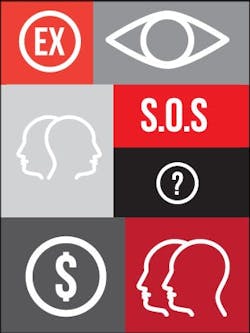John Anderson’s shop was trapped in the back of an industrial complex, out of sight and out of mind for any potential customers.
“If anyone drove by, it was because they were lost,” he says.
Anderson had been able to slowly grow his Olathe, Kan., shop, Anderson Automotive, since opening in 1996. Staying in the same location, he expanded into some office space next door in 2001, and two years later felt the business was poised for a boom.
He began looking for opportunities to build a new facility.
“I really thought we were doing well, and it seemed like we were busting at the seams a bit,” he says. “I just thought, getting in a better traffic area and a better location, we would really take off.”
In a thriving real estate market, Anderson was able to find a 17,000-square-foot facility—a building more than double the size of his previous one—on a prime thoroughfare in the same area of town for the same price as a facility a fraction of the size. Seizing the opportunity, he moved Anderson Automotive into the new digs in 2003.
Changing the company structure, though, proved more difficult than Anderson had initially anticipated.
“You name a mistake or a problem, and I’d bet we went through it,” he says with a laugh.
And the reason Anderson can laugh now is that he and his staff have righted the ship in the last several years. Due to a series of operational changes, Anderson Automotive’s sales volume grew 17 percent year-over-year in 2011, another 18 percent in 2012, and is on pace for a 35 percent boost in 2013.
“The key is that you learn from your mistakes and improve because of them,” he says.
Anderson and Bryan Kauffeld, who successfully oversaw his 77-year-old business’s recent expansion, spoke with Ratchet+Wrench to help their fellow shop operators eliminate that trial-and-error period. They laid out their 7 Deadly Sins of Change Leadership—and what you can do to avoid them.
Sin No. 1: Unrealistic Vision
When expanding his business, Anderson was obsessed with location. His team in place—four technicians and one front desk worker—was efficient, and giving his staff more space, he thought, would only increase their output. So, during the transition, he focused entirely on operations and layout of the new building: If we build it, they will come, he thought.
Well, they didn’t. After a year in the new location, the shop had solid output—for a business half the size. Aside from the occasional walk-in customer, Anderson says business was no different than it had been before the move.
The Mistake: A leader is in charge of the overall vision of the business, Anderson says. He had an unrealistic approach to achieving his.
The Solution: Better planning. If he had to do it again, Anderson says he would’ve been more deliberate with planning how the change would affect each facet of business. He ignored marketing, customer habits, his staff’s ability to take on more work. For any change, large or small, it’s important to look into even the slightest of details, he says.
Sin No. 2: Buddy-Buddy Employee Relationships
For Kauffeld, he grew up in his father’s shop, Ulmer’s Auto Care Center in Milford, Ohio. When he became a 50-50 partner with his father in 2002, and immediately set about modernizing the business’s approach, much of his staff struggled with the changes.
The same could be said for Anderson, who says his staff became more and more reliant on him to solve problems as the shop saw new daily challenges in the larger facility.
“Any problem, people were coming to me for an answer, for me to fix it,” he says.
The Mistake: Both Kauffeld and Anderson say there wasn’t enough “separation” between them and their staff. “They saw me as a buddy,” Anderson says. “And they leaned on me far too much.”
The Solution: Create structure—and procedures. Anderson began creating standard operating procedures (SOPs) for every aspect of operations. Employees were to exhaust all resources laid out in their SOPs before running to him.
Sin No. 3: ‘Robbing Peter to Pay Paul’
Kauffeld oversaw his business’s expansion into a second facility in Anderson, Ohio, roughly 10 years ago. Because of the shop’s long history and reputation, he felt shifting some well-respected employees to the new facility would give it instant credibility.
It may have, he says, but it also helped to weaken production at the Milford shop.
The Mistake: Kauffeld says change cannot work if you have to hinder another aspect of the business to pull off the transition. Don’t “rob Peter to pay Paul,” he says.
The Solution: It starts with the planning concept laid out in “Sin No. 1,” but Kauffeld says you also have to think of the change you’re making as “isolated” from other areas of the business. That is to say, if you can’t reallocate company resources to pull off the change without hurting another aspect of the company, then you need to make the change with entirely new resources (increased funds, additional employees, different equipment, etc.).
Sin No. 4: Ignoring Employees’ Needs
Anderson had an idea to jumpstart car count in his new facility: stay open on Saturdays. Adding a full day of work to his business’s operations was sure to increase sales significantly.
But, when he approached his staff with the idea, they were far from enthusiastic. No one wanted to be stuck with the Saturday shift, and his staff instantly fought the change.
The Mistake: Anderson says he didn’t evaluate his employees’ needs as well as he should have. And too many shops, he says, make changes “for the good of the company,” without thinking of how it affects the people who make the company what it is.
The Solution: Anderson held a meeting with his employees to go over possible solutions. To the satisfaction of his entire staff, they reworked work hours to where each technician worked four, 10-hour days each week, on a rotating schedule of who would work the weekend shift.
“You have to give your employees a stake in what’s going on,” Kauffeld says. “You need to understand who they are and if they fit your culture. To make changes, they all have to be on board.”
Sin No. 5: Clueless on Customer base
Kauffeld says he took his shop’s reputation for granted when opening the second location. The Ulmer’s name, he thought, was all he needed to jumpstart business.
“We went over to Anderson, which is about 18 miles away, with the exact same approach to everything,” he says. “We did the exact same type of marketing.”
The only problem was the customers didn’t respond to it. The shop was slow in getting off the ground.
The Mistake: Kauffeld says he didn’t look heavily enough into the demographics of his new customer base, which turned out to be just different enough from his Milford location that the same marketing tactics didn’t apply. Bottom line: He didn’t examine how the change in his business would be affected by his customers.
The Solution: It’s really simple, Kauffeld says: Religiously study your customer base. Take the “top” 200 customers from your database, and study their demographic information. Those are the people you want in your shop; now design your operations and marketing to fit their needs.
Sin No. 6: Setting the Example—incorrectly
Both Anderson and Kauffeld had some chaotic moments in transitioning their businesses. And it was often easy for them to get distracted from their necessary tasks.
“I was too busy trying to get things done and put out fires that it was hard to focus on every detail of what our company should’ve been about,” Anderson says.
The Mistake: Anderson says, at the time, he failed to set the right example for how he wanted his staff to act. Employees will follow your lead, he says, and that’s not always a good thing.
The Solution: Kauffeld says if you want to see a change in your business, you have to set the example for it. You can’t tell employees to follow a new policy, he says, and then ignore it when it’s not convenient for you.
Sin No. 7: Stranded on an Island
Looking back, Anderson says his shop likely wasn’t as maxed out in terms of production as he thought it was prior to the move. In recent years, he has learned new operational techniques—and he has improved his own managerial and leadership abilities—to allow for drastic increases in sales.
The 10-bay, five-technician shop did $1.3 million in sales in 2013, numbers he now feels he should’ve been able to reach in his former building.
The Mistake: Anderson made all of his business decisions in-house, with his staff and wife as his only sounding board. Far too many repair shops, he says, tend to operate on an island.
The Solution: Having a trusted advisor—someone on the outside of the company who can offer an objective viewpoint—is critical to understanding your shop and how change will affect it. Find a mentor in your area, hire a business coach, join a 20 Group or an industry association—whatever the route, Anderson says you must have that guidance.
Anderson hired an industry consultant and now participates in 20 Groups. The timing of seeking outside help correlates exactly to his business’s recent improvements.
“I was lucky that I could get by for so long because our building was so cheap—we got 21 bays of space for the price of eight,” he says. “But I’m now looking to fill out [the whole facility] and really grow. You can’t do it alone.”
About the Author

Bryce Evans
Bryce Evans is the vice president of content at 10 Missions Media, overseeing an award-winning team that produces FenderBender, Ratchet+Wrench and NOLN.
